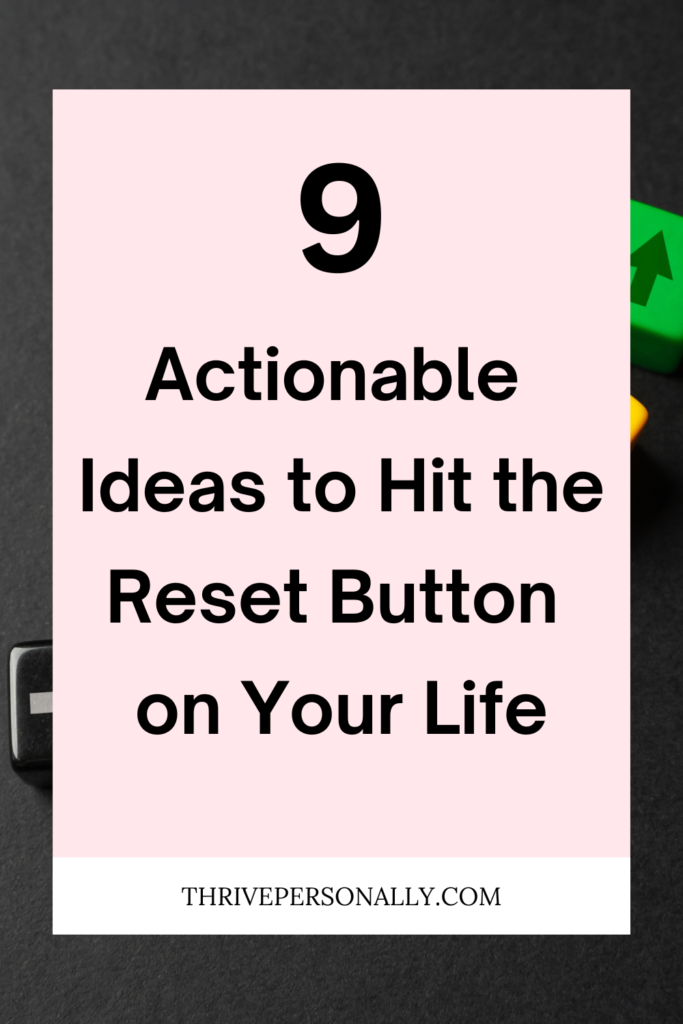In the fast-paced environment of today’s society, individuals often find themselves grappling with numerous challenges that can prompt the desire for a reset in life. Stress, burnout, and disillusionment are among the most common issues that lead people to seek a fundamental change in their circumstances.
Such challenges can arise from multiple sources, including work-related pressures, personal relationships, and emotional fatigue. Recognizing the signs that one needs a reset is crucial for initiating a journey towards personal growth and fulfillment.
Stress is a prevalent factor impacting mental and physical health. When individuals become overwhelmed by ongoing responsibilities and expectations, they may experience symptoms that negatively affect their daily lives.
This persistent pressure can lead to a cycle of anxiety and disengagement, making it challenging to maintain a sense of purpose and satisfaction. As these feelings accumulate, asking oneself whether a reset is necessary can become vital for reclaiming one’s mental well-being.
Moreover, disillusionment can arise when expectations do not align with reality. Instances such as unmet career aspirations or unfulfilling relationships can lead to a pervasive sense of dissatisfaction.
Here are the 9 Actionable Ideas to Hit the Reset Button on Your Life
1. Reflect on Your Current Situation
Self-reflection is an essential process that enables individuals to evaluate their current life circumstances. By engaging in reflective practices, such as journaling and meditation, one can cultivate a deeper understanding of personal thoughts, emotions, and aspirations, ultimately paving the way for meaningful changes.
It is vital to allocate time dedicated solely to this introspection, which can significantly enhance personal and professional clarity.
Journaling is a particularly effective tool for self-reflection. It allows individuals to articulate their feelings, track life events, and clarify their goals. A helpful approach may involve setting a specific time each day to write freely about experiences and emotions.
While journaling, consider addressing pivotal questions such as: What aspects of my life currently bring me satisfaction? What areas feel unfulfilling? By identifying the elements that contribute positively to overall well-being and those that detract from it, individuals may develop insights necessary for initiating a reset.
Another valuable strategy is meditation, which helps quiet the mind and fosters a greater awareness of the present moment. This practice can enhance mindfulness, allowing individuals to observe their thoughts and feelings without judgment.
During meditation sessions, focus on the following inquiries: Are there recurring themes in my thoughts? What desires have I been neglecting? By contemplating these questions, one can uncover motivations and aspirations that may have been overshadowed by external pressures or distractions.
2. Set Clear and Achievable Goals
The process of setting clear and achievable goals is essential for effectively resetting one’s life. By establishing a structured approach to goal setting, individuals can ensure that their aspirations are realistic and aligned with their personal values and desires.
Utilizing the SMART criteria is a pragmatic method for cultivating purposeful goals. SMART stands for Specific, Measurable, Achievable, Relevant, and Time-bound. This framework encourages individuals to outline their goals in a precise manner, facilitating a clear understanding of what they wish to attain.
To begin, it is critical that goals are specific. Vague aspirations can lead to uncertainty and frustration. Instead of stating a desire to “get fit,” a more useful specific goal would be “to exercise for 30 minutes five times a week.” This specificity provides a clear direction and focus.
Achievability is another crucial component. It is essential to ensure that goals are realistic and within reach, considering personal circumstances and resources.
This aligns with the concept of setting relevant goals, which should resonate with one’s core values and long-term vision. For example, if career advancement is a priority, educational goals may align well with this ambition.
Lastly, establishing time-bound deadlines infuses a sense of urgency and commitment to the goals. A clear timeframe can motivate individuals to act and maintain focus.
By segmenting larger objectives into smaller, manageable steps, one can mitigate feelings of overwhelm and steadily progress towards their ultimate goals. This method not only enhances motivation but also reinforces the habit of achieving incremental successes.
3. Prioritize Self-Care and Well-Being
In the journey of resetting one’s life, prioritizing self-care and well-being stands out as a crucial step. Self-care encompasses a range of practices aimed at maintaining and improving one’s health and happiness. Establishing a self-care routine is essential; this can include setting aside time each day or week for activities that nourish the mind, body, and spirit.
Activities can range from simple practices like reading a book or taking a warm bath to more involved ones like engaging in artistic pursuits or gardening. The key is to choose activities that resonate personally and provide a sense of rejuvenation.
Engagement in physical activity is another vital element of self-care. Regular exercise contributes not only to physical health but also boosts mental well-being. Even moderate activities such as walking, cycling, or yoga can significantly impact mood and reduce stress levels.
The release of endorphins during physical activities enhances emotional resilience, allowing individuals to better cope with life’s challenges. Therefore, integrating such activities into daily life can result in notable improvements in both physical and mental states.
Additionally, ensuring adequate rest and nutrition is fundamental when prioritizing self-care. Sleep is essential for cognitive functions and emotional stability; thus, establishing a sleep routine can significantly improve overall well-being.
Complementing restful sleep with a balanced diet provides the body with essential nutrients, contributing to better physical health and mental clarity.
4. Evaluate Your Relationships
Relationships play a crucial role in shaping our emotional well-being and overall quality of life. Evaluating one’s relationships involves a thoughtful examination of how each connection impacts your mental and emotional health.
Begin by reflecting on your social circles and identifying individuals who contribute positively to your life. Supportive relationships provide encouragement, empathy, and understanding, enhancing your resilience during challenging times. Conversely, toxic relationships can drain your energy and lead to negative feelings, such as anxiety and stress.
To assess your relationships effectively, consider using a simple framework: categorize your connections into three groups—supportive, neutral, and toxic. Supportive individuals nourish and uplift you, while neutral relationships do not evoke strong emotions.
Toxic relationships, however, may create conflict, instill fear, or exacerbate your insecurities. As you identify these groups, prioritize nurturing those who have a positive influence on your life, dedicating time and effort to strengthen these beneficial connections.
Strengthening supportive relationships can be done through open communication and mutual respect. Regularly check in with these individuals, express gratitude, and engage in shared activities that foster a deeper bond.
Additionally, consider joining community groups or platforms that align with your interests to expand your network of uplifting relationships.
On the other hand, disengage from harmful relationships by setting clear boundaries. This may involve limiting interactions with toxic individuals or having candid conversations about your feelings.
It is in your interest to protect your emotional health and well-being by deliberately choosing who you allow into your life. In time, this process will lead to a healthier support system, allowing you to thrive as you hit the reset button on your life.
Related: Simple Ways to Build Your Self-Confidence
5. Embrace New Experiences and Opportunities
Stepping out of one’s comfort zone is often a catalyst for personal growth and transformation. Embracing new experiences and opportunities can unlock pathways to learning, creativity, and self-discovery.
When individuals challenge themselves by engaging in activities that are unfamiliar or daunting, they not only expand their skill sets but also foster resilience and adaptability. This can be particularly beneficial in a fast-paced world where change is a constant presence.
One effective way to embrace new experiences is through travel. Exploring different cultures and environments exposes individuals to new perspectives, enhancing empathy and understanding.
Whether it is a weekend getaway to a nearby city or an overseas excursion, travel allows individuals to step into unknown territories, literally and figuratively. Incorporating local customs, trying diverse cuisines, and interacting with residents can significantly broaden one’s horizons.
Hobbies also present a wonderful opportunity for personal expansion. Engaging in activities such as painting, dancing, or learning a new language can stimulate creative thinking and provide a sense of accomplishment. These endeavors not only serve as outlets for self-expression but also enable individuals to connect with others who share similar interests, fostering a sense of community.
Volunteering is another powerful way to embrace new opportunities. Dedicating time to serve others can offer fresh insights into the struggles and triumphs of different communities.
It can also be a profound reminder of the impact one can have, which, in itself, can be incredibly reinvigorating. By participating in local charities, mentorship programs, or environmental initiatives, individuals position themselves to gain not only new skills but also enriching experiences that can spark a transformative change.
6. Practice Mindfulness and Gratitude
In the quest for personal reset, practicing mindfulness and cultivating gratitude emerge as potent tools that offer both mental clarity and emotional resilience.
Mindfulness refers to the intentional focus on the present moment, allowing individuals to experience their thoughts and feelings without judgment. This practice can significantly reduce stress and enhance overall well-being, establishing a firm foundation for personal transformation.
One effective technique for practicing mindfulness is meditation. Regular meditation sessions, ranging from just a few minutes to longer periods, can help center the mind and promote relaxation. Individuals can start by finding a quiet space, sitting comfortably, and focusing on their breath.
As thoughts arise, it is essential to acknowledge them and gently guide the focus back to the breath, reinforcing the core principle of mindfulness: living in the present. Additionally, group meditation or mindfulness classes provide a supportive environment, enhancing both commitment and understanding of the practice.
Breathing exercises also play an integral role in incorporating mindfulness into daily routines. Simple techniques, such as inhaling deeply for a count of four, holding the breath for four, and exhaling for another count of four can ground individuals in the moment. This practice can be particularly beneficial during stressful situations, offering a quick reset and fostering a sense of peace.
On the other hand, cultivating gratitude shifts focus from challenges to the positive aspects of our lives, creating a more appreciative mindset.
Daily gratitude exercises, such as maintaining a gratitude journal where one lists three things they are thankful for each day, can significantly transform one’s outlook. Acknowledging both large and small blessings allows individuals to reframe challenges and recognize the abundance in their lives.
Together, mindfulness and gratitude create a holistic approach to resetting one’s life, promoting a balanced and fulfilling lifestyle.
Related: 9 Practical Steps to Find Fulfillment When Life Feels Empty
7. Declutter Your Physical and Digital Space
Decluttering is a critical step towards achieving both physical and mental clarity in our lives. The benefits of removing unnecessary items from our surroundings are profound, as a tidy environment promotes better focus, productivity, and overall well-being.
Tackling physical clutter can begin with a thorough assessment of your space, identifying items that no longer serve a purpose or bring joy. Start by categorizing belongings—clothes, books, gadgets—and systematically evaluate whether they are essential. This practice not only frees up space but also allows for a refreshed perspective on what truly matters in life.
As we shift our focus to digital spaces, similar strategies can be applied to manage digital clutter effectively. The proliferation of information can lead to what many refer to as digital overload.
To counter this, it is advisable to streamline your email inbox. Start by unsubscribing from newsletters and promotional emails that clutter your inbox and distract from crucial messages.
Consider arranging emails into folders or categories to prioritize those that require immediate attention. This organization makes it easier to locate important information and decreases anxiety associated with an overwhelming inbox.
Social media platforms are another source of digital clutter that can impact mental well-being. Engage in a social media cleanup by reviewing your connections and following only those profiles that contribute positively to your life.
Limit your exposure to negative content, which can often proliferate on these platforms. By curating your digital environment, you enhance your mental clarity and foster a more positive online experience.
8. Seek Continuous Learning and Personal Development
In today’s rapidly evolving world, the pursuit of knowledge and skills has become an essential element of personal growth. Embracing lifelong learning not only enriches one’s life experience but also aids in achieving reset goals, providing individuals with tools that foster both professional and personal development.
A growth mindset, which is the belief that one’s abilities and intelligence can be developed through dedication and hard work, plays a critical role in this journey.
To kickstart the process of continuous learning, one can consider enrolling in various courses. These may range from academic subjects to specialized training in areas of interest.
Online platforms such as Coursera, Udemy, or local community colleges offer numerous opportunities for individuals to strengthen their knowledge base and learn new skills at their own pace.
Furthermore, these courses often provide certifications that can enhance one’s professional profile, making them not just a learning experience but a career-boosting endeavor.
Another effective way to foster personal development is by engaging with self-help literature. Reading books that focus on personal growth, psychology, and self-improvement can provide valuable insights and guidance on navigating various life challenges.
Authors such as Brené Brown, Carol Dweck, and Tony Robbins offer perspectives that inspire action and reflection, enabling readers to apply new concepts to their own lives and activities.
Additionally, attending workshops and seminars can also broaden one’s horizons. These events often feature experts in various fields who share their knowledge and experiences, providing valuable networking opportunities. Participants can engage in interactive activities and discussions that further enhance their learning experience, making it a dynamic way to absorb and apply new information By adopting a mindset centered on personal development and continuous learning, individuals can better align their abilities with their reset goals, ensuring that their journey through life remains fulfilling and impactful.
Related: Tips to Enjoy Every Moment of Life
9. Create a Life Vision Board
A life vision board serves as a powerful visual representation of one’s goals and aspirations, acting as a daily reminder of what truly matters.
By aggregating images, words, and other forms of inspiration, individuals can create a tangible roadmap that guides their journey towards personal success. The concept behind a vision board is to provide clarity on desires and ambitions, effectively outlining the steps necessary to achieve them.
To begin creating a life vision board, start by gathering materials such as a poster board or corkboard, along with scissors, adhesive, markers, and magazines, or digital platforms that allow for creative design.
The next step involves defining personal goals, aspirations, and values that the board will represent. This foundational work is crucial, as it provides direction and ensures that the chosen visuals align with what one genuinely seeks in life.
When selecting images and words, focus on those that evoke strong emotions or resonate deeply with personal experiences. For example, if health and wellness are a priority, include pictures of fitness activities or healthy meals.
In contrast, if travel and exploration are goals, consider adding images of destinations that inspire wanderlust. Arranging these elements creatively on the board can facilitate an enjoyable process, turning intention into action.
Regularly revisiting and revising the vision board is essential for maintaining motivation and inspiration. As life evolves, so too do personal aspirations. Setting aside time periodically—perhaps at the start of each season—to assess progress and update the vision board allows individuals to reflect on their journeys and make necessary adjustments. This practice fosters a dynamic relationship with one’s goals, ensuring that they remain relevant and energizing.
Save the pin for later



